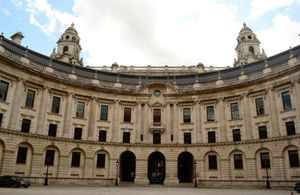Way forward for digital radio agreed
Plans to extend local digital radio coverage moved a step closer today.

Government, the BBC and commercial operators have signed a joint agreement, establishing the framework for up to £21 million of new investment in radio infrastructure. Local Digital Audio Broadcasting (DAB) coverage must be increased before any decision on radio switchover can be made.
The Memorandum of Understanding (MoU) establishes an agreement in principle to fund the build-out of local DAB to FM equivalences over the next 5 years, with a clear commitment to consider further funding if necessary. The MoU also paves the way for the launch of at least five new local multiplexes, including in Oxfordshire and Gloucestershire, which will provide new local digital radio services to approximately 1.25million listeners. In addition, the MoU confirms the Government’s commitment to a decision on radio switchover in 2013.
Communications Minister Ed Vaizey said:
“This is a positive and significant step forward for the future of digital radio in the UK. As more and more listeners make the switch to digital, it’s vital that we keep on increasing the areas able to receive a digital signal. Government, the BBC and the commercial operators are working together to ensure this happens.”
Government will now ask Ofcom to form a joint planning group, which will be tasked with producing the technical and implementation plans for a radio switchover. Work will also continue on the Digital Radio Action Plan to ensure that the Government has all of the information necessary to make an informed decision on radio switchover in 2013.
The signing of the MOU comes at the same time as the publication of a methodology report on the Government’s cost benefit analysis (CBA) of a radio switchover. It details the inputs and assumptions on which the cost benefit analysis is based, including expected consumer behaviour and future market growth. To ensure that the conclusions of the CBA are robust, Government is seeking views about the proposals set out in the report.
The report is available on the DCMS website and any comments or suggestions can be sent to CBARadio@culture.gsi.gov.uk until Friday 31st August 2012.
Notes to Editors
- KEY DIGITAL RADIO FACTS (Sources: RAJAR Q1 2012, GfK)
* 29.2 per cent of all radio listening is to digital platforms, up 11 per cent year on year
* 50 per cent of all radio listeners listen via a digital platform each week
* Of all listening: 19.1 per cent is to DAB (up 15 per cent year on year), 4.4 per cent to DTV (up 7 per cent year on year), 3.9 per cent Internet (up 8 per cent year on year)
* Of digital listening, 70 per cent is to DAB (excluding digital not stated)
* 42.6 per cent of adults have a digital radio in the home
* Digital radio sales have now reached 15 million in total.
* Recent figures show growth in digital radio sales including Internet radios (up 8 per cent in volume in the period Feb 12-Apr 12 compared to the same period year before).
* Car DAB audio sales grew by 40 per cent for the three months Jan-Mar 2012 compared with the same period in the previous year
* 26.1 per cent of new car registrations in April 2012 had digital radio fitted as standard, up from 10.7 per cent in April 2011 (source: CAP/SMMT)
- MoU Background
* The purpose of the MoU is to set out the framework for how to proceed with the build out of local DAB, to increase the coverage initially to 90% of FM equivalence to fulfil the Government criteria for radio switchover, and then to match FM equivalence across the UK.
* The MoU is a non-legally binding agreement which represents the commitment from Government, the BBC and the radio industry to work together in the planning and implementation of the build out.
* The MoU outlines three key phases of the process: Phase One - Action prior to the 2013 radio switchover decision Phase Two - Post 2013 radio switchover decision to 90 per cent local DAB coverage Phase Three - Extending local DAB coverage from 90 per cent to FM equivalence
* The signing of the MoU signifies the beginning of Phase One. Government will now task Ofcom to establish and Chair the Joint Planning for Radio Group (JPRG). The JPRG will be comprised of signatories to the MoU and will look at each multiplex area to establish the most effective means of increasing the coverage in those areas to reach FM equivalence. The JPRG will produce a Technical Switchover Plan and a Switchover Implementation Plan which in combination will outline every technical piece of infrastructure work that needs to be made along with providing when and how the work should be completed.
* Phase One also requires five additional local DAB multiplexes to be launched within 18 months of the signing of the MoU. The new multiplexes will be in: Gloucestershire; Hereford and Worcester; Northamptonshire; North East Wales and West Cheshire; and Oxfordshire.
* Phase Two will be implemented subject to a positive in principle decision on switchover occurring and a further legally binding agreement on funding being in place. The purpose of Phase Two is to increase local DAB coverage to fulfil the switchover criteria of local DAB reaching 90% of FM equivalence. Once the 90% criteria has been reached the Secretary of State will be able to exercise the powers contained in the Broadcasting Act 1990 to nominate a date or dates for radio switchover and enter Phase Three. Phase Three will be completed once local DAB coverage reaches current FM equivalence.
- Memorandum of Understanding on Local DAB Funding for Radio Switchover was published 11 July 2012 and is now available on the DCMS website.
Press Enquiries: 020 7211 2210
Out of hours telephone pager no: 07699 751153
Public Enquiries: 020 7211 6000